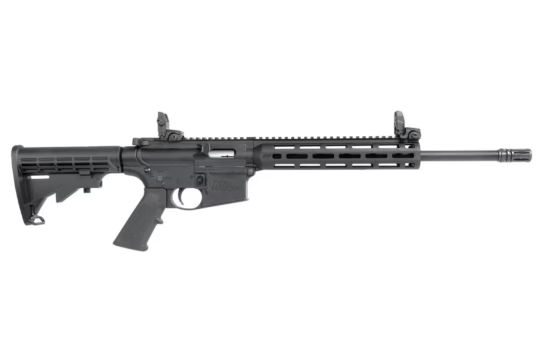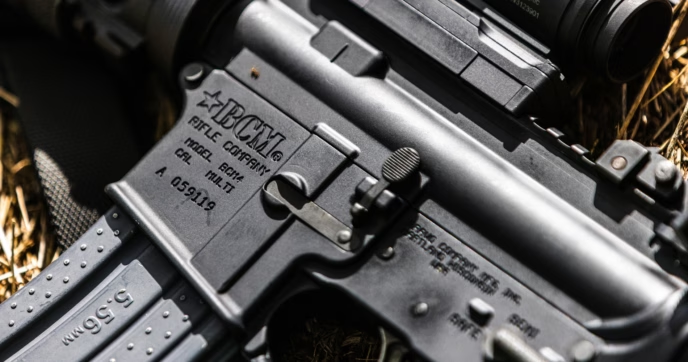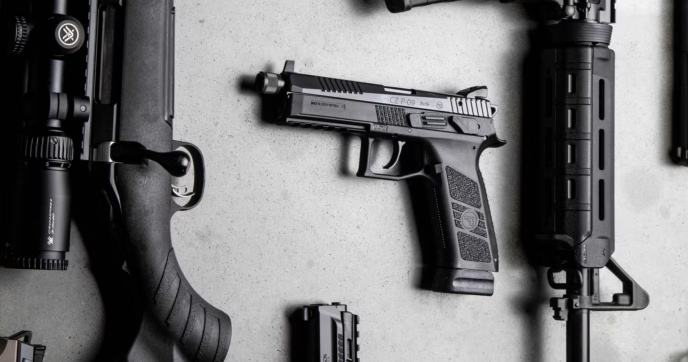Ever since its creation, the AR-15 has been in a near-constant state of evolution, with it being adapted to fit numerous applications and individual needs. Despite the standard cartridge being 5.56 NATO, the platform has been the host for a wide array of calibers, big and small.
One such caliber is .22 Long Rifle, better known as just .22LR. While most often associate .22LR with rimfire semi-automatics like the Ruger 10/22, many who are new to the AR-15 are sometimes surprised to hear that .22 LR is one of the more popular chamberings for the platform.
In fact, .22 caliber AR-15s are often used by many trainers to get new enthusiasts familiar with the functionality of the AR platform. In the same vein, those already adept with the platform use them to train on a budget. While this can be achieved with a dedicated .22LR AR-15, you can also opt for a conversion kit—and since there’s options, it’s crucial to understand them so you can make the right choice based on your preferences.
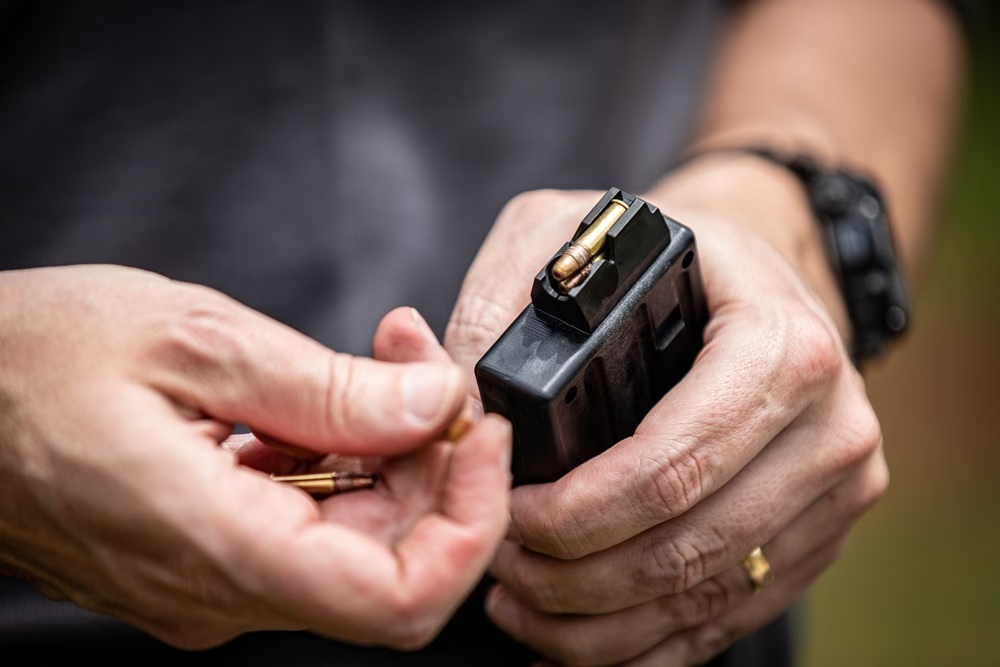
What is .22LR?
Before getting into the weeds on rimfire AR-15s, it’s crucial to know what sets .22LR apart from standard AR calibers like 5.56 NATO. First introduced in 1887, .22LR is a small, rimfire cartridge designed for recreational shooting, as well as small game hunting. Since its introduction, it’s been used on both rifles and pistols, and it has consistently been one of the most budget-friendly calibers with it costing as little as $0.03 to $0.05 per round in most instances.
The big question remains—what is the main difference between centerfire and rimfire ammunition? Primarily, it’s their primers. Centerfire cartridges, like 5.56 NATO, use a separate primer to ignite the cartridge’s propellant (gunpowder). The firing pin on centerfire rifles pierces these primers, which then ignites the powder to propel the cartridge forward. Rimfire cartridges, like .22LR, have the primer placed directly into the casing’s rim, hence the name ‘rimfire’.
Why Choose .22 LR over 5.56 NATO?
One of the primary reasons enthusiasts might opt for .22LR over 5.56 NATO, is the cost difference. 5.56 NATO, while not a particularly expensive cartridge, typically costs around $0.50+ per round. This makes .22LR far more budget-friendly, as it costs around $0.05 per round, as mentioned above. Furthermore, .22LR is a great round for training.
Because of its smaller size and soft recoil impulse, .22LR is often the go-to round for plinking targets at the range. In particular, .22LR AR models are often used by both new and seasoned enthusiasts, as they give you the ability to train and hone your skills with an AR without needing to spend hundreds on ammo each time you go to the range.
.22LR AR-15s
If you’ve made it this far and are leaning towards buying a .22 AR, there’s two distinct ways to utilize the caliber. You can either opt for a .22 LR AR conversion kit, or you can buy a dedicated AR-15 chambered in .22LR.
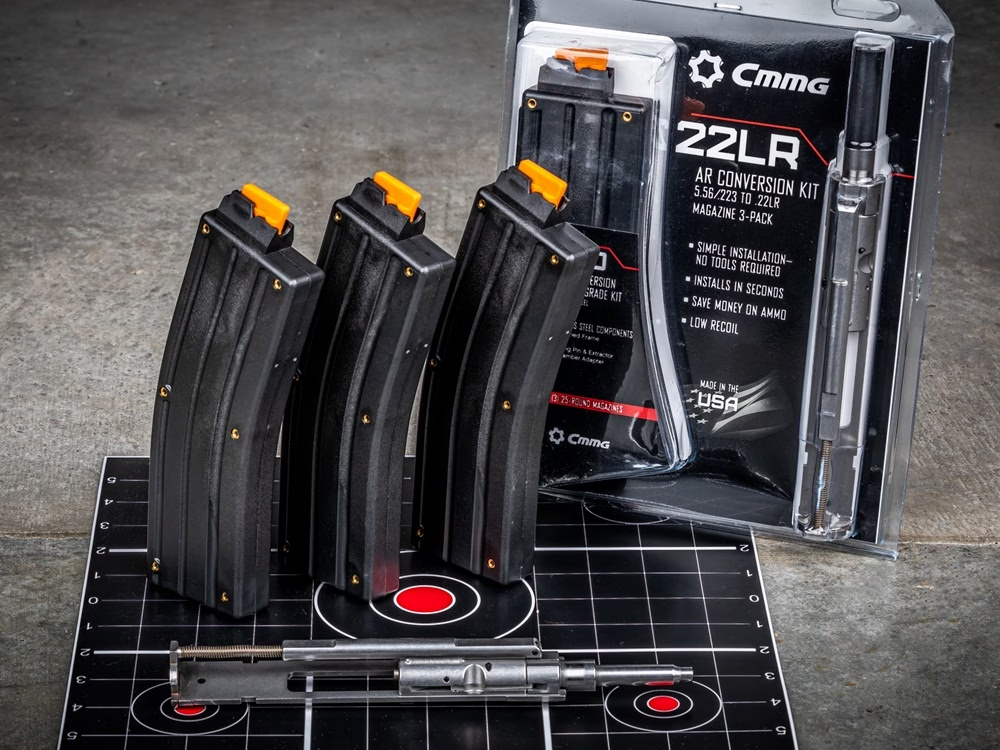
Conversion Kits
.22LR conversion kits are great if you already own an AR-15 chambered in 5.56 NATO. Despite being a larger cartridge, both 5.56 NATO and .22LR make use of a .223-inch diameter projectile, meaning there’s no need to swap out your rifle’s barrel when using a conversion kit.
Rather than overhauling your rifle build, all that you need to change out on your rifle is the bolt-carrier group (BCG) and the magazines—with these being the components that are included in conversion kits. Also, since .22LR doesn’t produce nearly as much energy as 5.56 NATO, .22 BCGs use a direct blowback design, so you won’t need to worry about changing your rifle’s barrel, gas system, or buffer assembly. Simply replace the 5.56 BCG with the .22LR one, use the new magazines included with the kit, and you’re ready to go.
Pros of Conversion Kits
As mentioned earlier, conversion kits are best for those who already own an AR chambered in 5.56 NATO. Conversion kits like the CMMG .22LR Conversion Kit are far more budget-friendly than buying a new rifle, costing around $200. Plus, it comes with three 25-round magazines as well.
Additionally, they give you the opportunity to continue using your main rifle. Rather than having to kit out a new rifle that matches your main one, conversion kits allow you to continue practicing and building up positive repetitions with your existing AR-15. This makes them a great choice for those who prefer to train with live ammunition at the range, but don’t want to spend more on 5.56 NATO ammunition.
Cons of Conversion Kits
Despite their pros, conversion kits aren’t without their cons. For starters, if you don’t already own an AR-15, or if you have one that’s chambered in a caliber other than 5.56/.223, you won’t be able to use a drop-in conversion kit.
Moreover, although a 5.56 barrel can handle .22LR with no issues, they aren’t designed with .22LR in mind. 5.56 NATO AR barrels typically make use of either a 1:7, 1:8, or a 1:9 twist rate, while .22LR rifle barrels most often have a 1:14 or 1:16 twist rate. As such, your rifle’s overall accuracy can take a hit when using a conversion kit. This isn’t to say that your rifle is going to suddenly start throwing shots at 25 yards, but compared to a dedicated .22LR rifle, the difference can be noticeable.
Lastly, although this is more of a nitpick than a con, the direct blowback design used by most conversion kits can cause an increase in carbon fouling after firing. This can lead to malfunctions if you don’t clean your rifle, but so long as you clean it every so often, you shouldn’t have any problems.
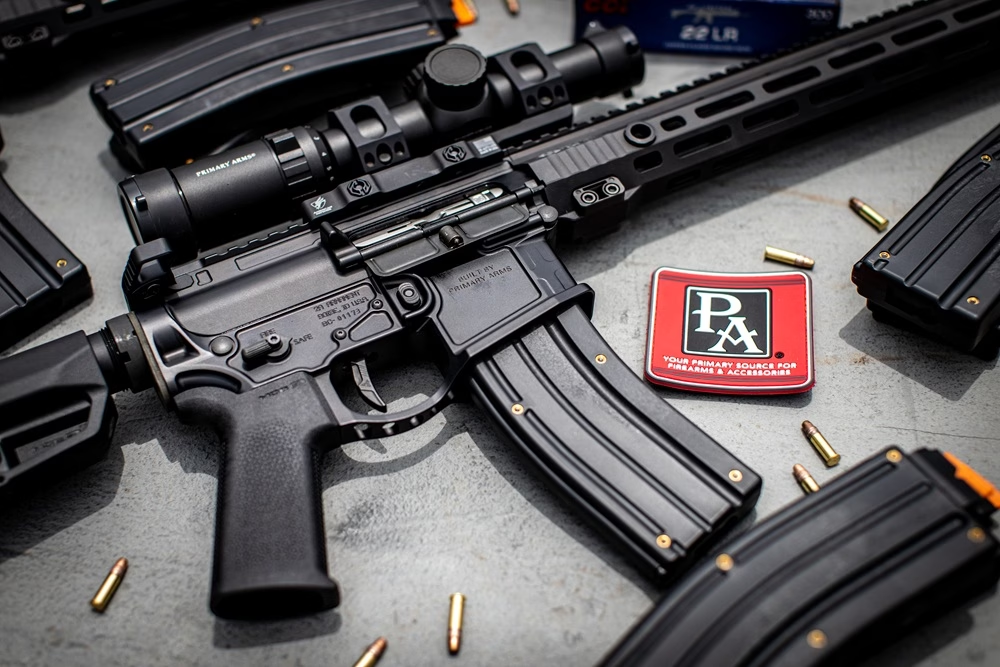
Are Conversion Kits Worth it?
Ultimately, it depends. If you already own a 5.56 AR-15, they can be a great investment. While they aren’t going to be as accurate as a dedicated .22LR AR, they’re a much more budget-friendly option compared to buying a new rifle.
With that in mind, if you don’t already own an AR chambered in 5.56, or want to maximize your rifle’s performance, it’d be wiser to search for a rifle that’s already chambered in .22LR. And fortunately, there are a lot of AR-15s on the market that come chambered in .22LR.
.22LR AR Style Rifles
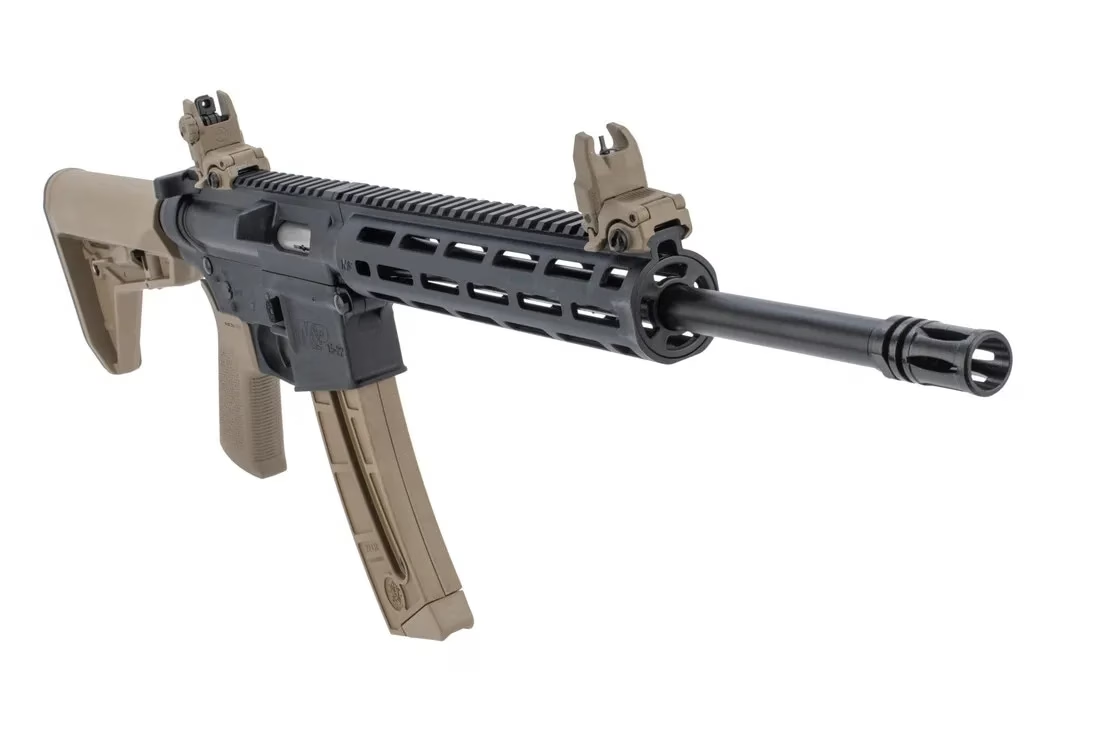
Smith & Wesson M&P15-22
One of the most popular .22 Caliber AR-15s is, by far, the Smith & Wesson M&P15-22. Available in multiple configurations, there are a plethora of Smith & Wesson .22LR AR rifles to pick from, with each one having a durable polymer construction, a 16.5-inch barrel, and an M-LOK handguard for easy accessory mounting.
Depending on which model you look at, they can come pre-equipped with various optics, including both iron sights and red dot sights. Additionally, they can also come with either standard mil-spec, Magpul, or B5 Systems furniture. Overall, the M&P15-22 is a solid .22LR AR that’s ready to perform out of the box. They’re a good budget-friendly possibility too, with them typically priced around $430 to upwards of $700 depending on the model.
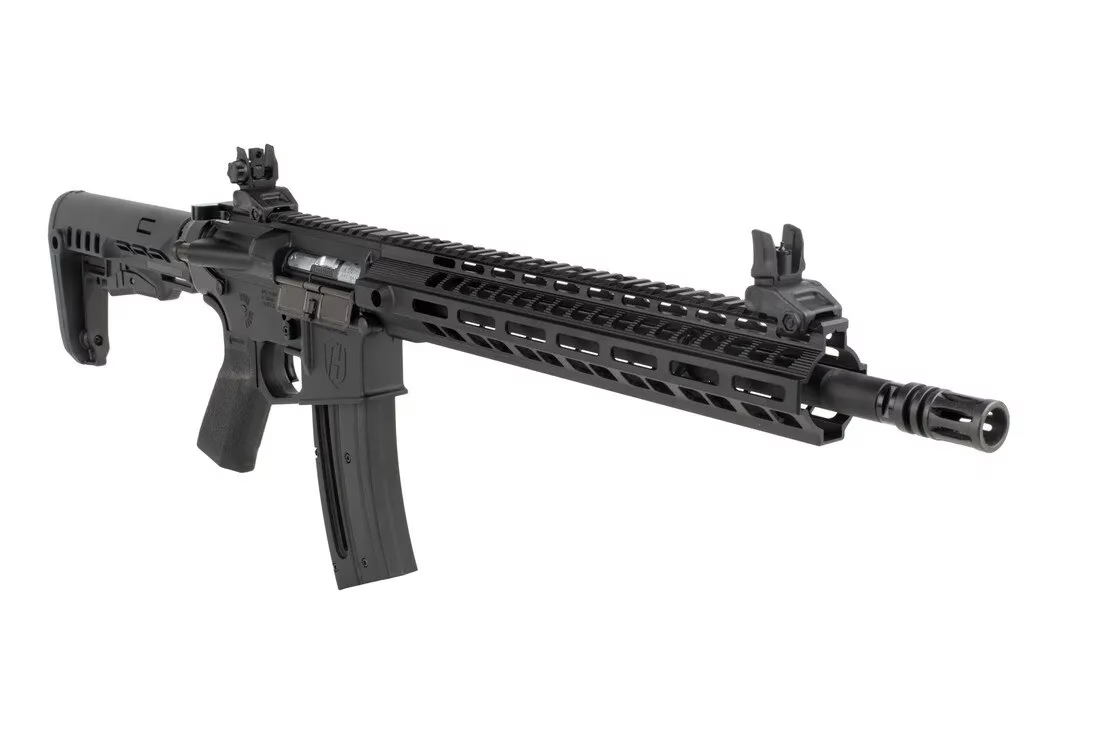
Walther Hammerli Tac R1
One of the more renowned names in the firearm space, Walther has long had a reputation for producing a plethora of top-tier pistols and rifles. Despite being most well-known for their centerfire models, their lineup is also home to rimfire ARs in the form of the Hammerli Tac R1.
The Hammerli Tac R1 is designed to offer reliable performance at an affordable price. It’s ergonomics and manual of arms are nearly identical to an AR-15’s—it utilizes a fully aluminum construction and comes standard with a full-length M-LOK handguard. Despite being based on the AR-15, it’s critical to recognize that their respective designs aren’t one-to-one. Tac R1 rifles aren’t fully compatible with standard AR components, but they still have a similar manual of arms. So, in the end, it’s still a solid pick, and it’s one of the more budget-friendly .22 ARs, with it priced around $410.
Conclusion
As one of the staple calibers in the firearm industry, .22LR has long been one of the go-to cartridges for recreational shooting, small game/varmint hunting, and for introducing new enthusiasts to firearms.
With it being so popular, it’s no surprise that .22LR AR-15s have risen to such a high regard. Today, there are a plethora of caliber conversion kits available for the AR-15, and there are even several dedicated AR-15 models chambered in .22LR. And since they have their own distinct pros and cons, it can be difficult to decide which one is best for you.
If you already own an AR-15 chambered in 5.56 NATO, a conversion kit is one of the best ways to go, allowing you to continue using your main rifle while making use of more budget-friendly ammunition. If you don’t already own an AR-15 or want to maximize your rifle’s performance, your best bet is to spring for a dedicated .22LR AR-15. No matter which route you go, each option will provide you with a great shooting experience fit for all budgets.
